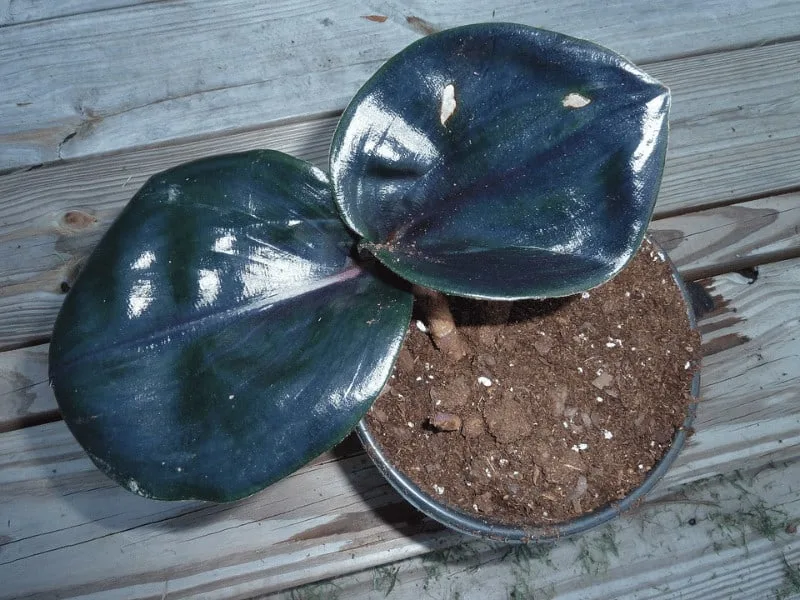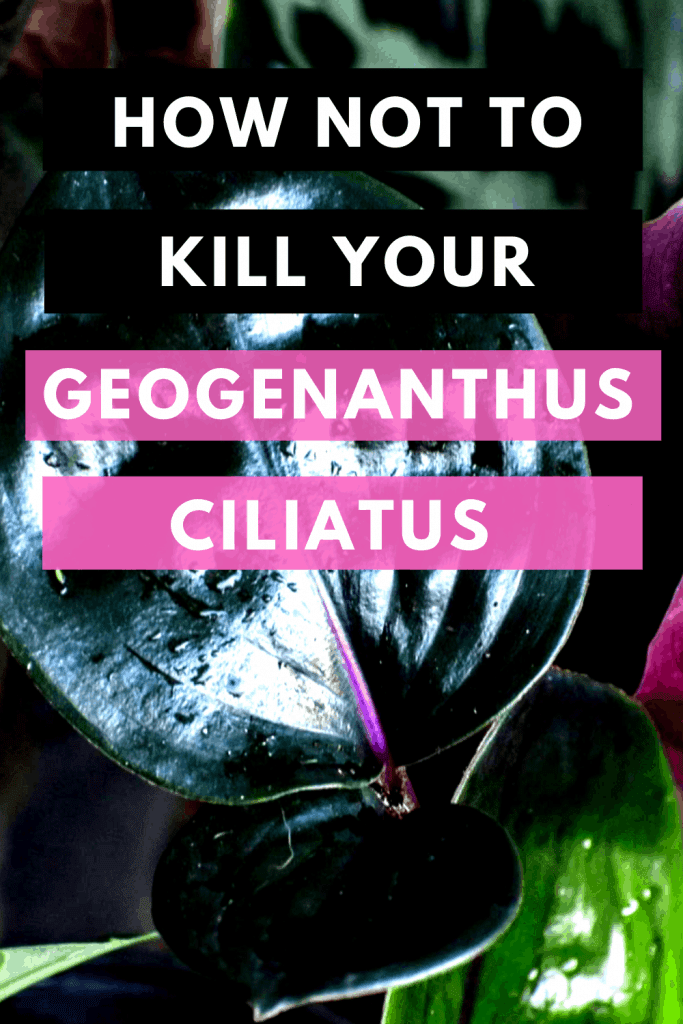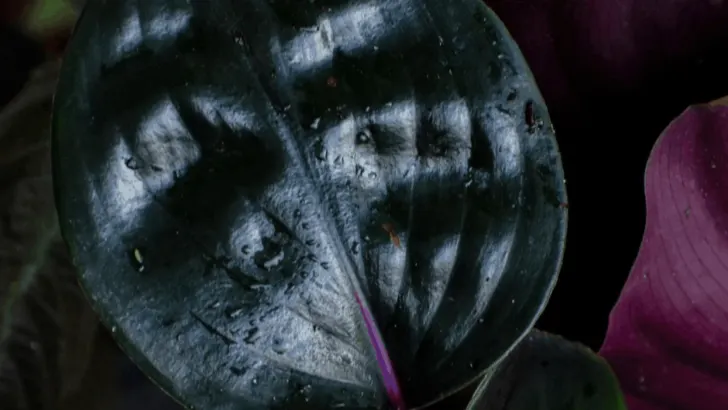(image credits: Kristi @atropicaldepression_)
Today’s rare plant is Geogenanthus ciliatus pronounced jee-oh-je-NAN-thus sil-ee-ATE-us.
Read more about Geogenanthus ciliatus care and plant information.

Geogenanthus ciliatus Takeaways
| Species | Geogenanthus ciliatus |
|---|---|
| Synonyms | Geo Plant, Ciliatus plant |
| Family | Commelinaceae |
| Genus | Geogenanthus |
| Growth | Upright, clumping |
| Height | 1.0ft / 0.3m |
| Width | 1.0ft / 0.3m |
| Soil | Well-draining potting mix. African violet potting mixture is optimal. The ideal pH level is between 6.1 to 7.3. |
| Watering | Every 7-14 days |
| Light | Bright indirect |
| Temperature | 65.0 – 85.0°F / 18.3 – 29.4°C |
| Humidity | 50.0 – 70.0% |
| Fertilizer | Once a month |
| Propogation | Division or rhizome cuttings |
| Toxicity | Non-toxic to animals such as cats and dogs as well as humans. Do not pets chew on the plant either way as it can upset the stomach. |
Table of Contents
Geogenanthus ciliatus
The common name for this plant is Geo plant or Ciliatus plant.
According to Kew Science, Geogenanthus ciliatus is a flowering plant from the Commelinaceae family, otherwise known as the dayflower & spiderwort family.
This plant is native to Ecuador, Colombia, and Peru. It grows on the rainforest ground. You can grow this annual in a pot or plant it in the outdoor garden, where it makes an attractive ground cover. Or you keep it as an indoor plant.
The deep-purple and green foliage is the unique feature of this Geogenanthus plant.

Geogenanthus ciliatus Care
Geogenanthus ciliatus needs a regular potting mix that drains well. An African violet potting mixture is optimal. The soil pH should be between 6.1 to 7.3. Keep it at 65 to 85 degrees Fahrenheit (18 to 29 degrees Celsius). This adaptable plant will thrive in low light (outside) to bright indirect sunlight (indoors).
What is the best Soil for Geogenanthus ciliatus?
Any average houseplant potting mixture is fine for Geogenanthus ciliatus. I suggest an African violet potting mix. You can use any of the following recipes depending on the ingredients available:
- Two parts peat moss, one part vermiculite, and one part perlite.
- One part peat moss with one part vermiculite or perlite.
- One part African Violet potting mix, one part peat moss, and one part perlite or vermiculite.
Another recipe is to go for a loam-based heavy potting mixture that contains peat moss and sand.
This rare plant will require a slightly acidic to neutralize the soil, so keep the pH from 6.1-7.3. If you want to grow it outside, I recommend USDA hardiness zones 10a to 12.
How much Water does Geogenanthus ciliatus need?
This attractive species has truly exceptional foliage. But you need to put in some effort to maintain the beauty of this plant, and watering is one of the most important features. This plant comes from a mesic habitat and needs a regular water supply.
Check the soil every few days to make sure it’s moist. Do not let the Geogenanthus Ciliatus plant dry out completely, as it prefers to stay on the wetter side.
As an indoor plant, Geogenanthus Ciliatus will require water more often, so check the soil to monitor soil dryness.
What Light is best for Geogenanthus ciliatus?
Bright indirect light is ideal for Geogenanthus ciliatus.
As an outdoor plant, this species will succeed in moderate shade protected from direct sun rays.
For indoor cultivation, choose a dim spot within your house. I would suggest giving partial or dappled sunlight as light is important for the coloration of the leaves.
Regarding sunlight, remember that Geogenanthus plants are low-light species, including Ciliatus; therefore, you can choose artificial lights as the light-medium. Artificial grow lights like inflorescent bulbs will give you more flexibility to create a low-light environment.
Geogenanthus ciliatus Temperature
Provide a temperature between 65-85 degrees Fahrenheit for Geogenanthus ciliatus (18.3-29.4 degrees Celsius).
This plant thrives in various temperature conditions, from warm to cool. But I would recommend maintaining the temperatures within the required range as this will ensure optimum growth.
The minimum temperature tolerated by Geogenanthus ciliatus is 50 degrees Fahrenheit (10 degrees Celcius).
I always ensure that my Ciliatus plant is positioned away from cold or drafty windows and doors because temperature fluctuations can hinder the growth of this houseplant.
How much Humidity does Geogenanthus ciliatus need?
During the day, the humidity should be 60 to 90%, whereas at night, 70 to 90%.
This species will like high humidity. The good news is there are more than one ways to raise humidity. The first one is to mist your plant regularly during the day. It is best to do this in the morning because the evaporation rate is low later in the evening.
Misting in the morning will allow the water to evaporate throughout the day to create a humid environment and protect the foliage from rotting or fungus.
Another foolproof method for maintaining the necessary humidity is to run a humidifier.
Geo Plant Fertilizer
I suggest using a good quality organic liquid fertilizer diluted at half strength once a week. You can go for a balanced ratio of 10-10-10.
This species has an active growing phase in spring and summer; therefore, it needs some extra nutrients.
This ensures all nutrients are equally distributed.
Diluting the fertilizer is important because overdosage can cause chemical burns or toxicity. It can also disturb the soil pH leading to ineffective soil mix.
Repotting
Geogenanthus Ciliatus has a tuberous root system that is robust and healthy.
This root system differentiates Geogenanthus from its close relatives like Cochliostema and Plowmanianthus. This plant should be repotted after one year.
If your plant does not need repotting after one year, leave it in its previous pot but refresh the potting mix using a fresh batch of African violet potting mixture.
Pruning
Although a low-maintenance plant, this ornamental species can be pruned for a fuller, bushier look.
I suggest pruning your Geogenanthus Ciliatus in late winter so your plant has new growth in the coming spring.
Trim any wounded leaves or stems because these can host diseases over the winter season.
The plant becomes dormant in winter, so the virus and bacteria can easily spread during this phase.
While pruning your Ciliatus, one extra suggestion is to use sharp tools to make clean cuts, which will heal rapidly.
Geogenanthus ciliatus Propagation
You can propagate Geogenanthus ciliatus using stem cuttings or rhizome division. Spring is the best time of year for successfully propagating a Geogenanthus Ciliatus.
Stem Cuttings
- Collect all the necessary tools for propagation; this includes pruning shears, rooting hormones, a small pot, and a regular houseplant mix.
- Make sure you take the cuttings when the plant is actively growing and not in the dormant period.
- Choose a short stem that is at least a few inches long. Make sure the cutting has at least two leaves. If your plant has very few leaves, choosing a stem with one leaf is also fine.
- Make a sharp cut after sterilizing your tools. Sterilization is important because it eliminates the risk of disease and fungus spread.
- Let the cut dry for a few hours, and later dip the end/node in a rooting hormone powder.
- Now take a small pot, and fill half of it with a free-draining mix. You can use African violet potting soil, as mentioned previously. Gently place the cutting in the middle of the soil.
- Hold the cutting straight with your hand and pour the remaining soil. You can use a wooden stick to support the cutting. Press the soil with your hand or a small spatula to firm it.
- Water it to moisturize the soil. Maintain a temperature of about 75 degrees Fahrenheit (23 degrees Celsius).
- You can also root this cutting in plain water for water propagation instead of soil.
Rhizome Division
- The tuberous root system of this species allows you to perform rhizome division.
- Please take out your plant from its pot. Make sure you don’t damage any foliage during this process.
- Dust away the soil around the tubers. You can also inspect the root system for any diseases or damage.
- You can apply a strong stream of water using a garden hose.
- After inspection and cleaning, take sterilized instruments for the division.
- Divide the plant into 2-3 sections. No of the sections will depend on the size of your Geogenanthus plant.
- Plant each section in a separate pot with a fresh batch of the potting mixture.
Geogenanthus ciliatus flower
The flowers of Geogenanthus ciliatus grow on 2 inches (5cm) long pedicels. Each flower has three greenish-brown sepals and three petals that are either blue or purple.
Growth
The young leaves are bright green with a purple stripe in the middle; however, as the plant matures, they change their color. The stems also have a beautiful color.
The upper surface of the leaves becomes dark green with a glossy finish, whereas the underside is dark-purple or maroon with a velvety surface. The leaves of this plant are classified as succulent, and each aerial stem has two leaves. The mature leaves are 6-8 inches in size.
A mature Ciliatus plant can get 6 inches (15 cm) high. This species is an understory plant which can withstand dryness and low light.
Other Uses for Geogenanthus Ciliatus
This plant was originally harvested from the wild for medical purposes; therefore, it is often classified as a medicinal herb. Some of the uses are:
- The leaves are boiled, and the decoction is utilized as a remedy for swollen knees.
- It is mashed with cold water to create a mixture. This mixture is given to infants orally as a remedy for worms.
Common Problems for the Ciliatus Plant
Lush and dark foliage makes this a must-have plant, but you might find some issues while growing this plant. These are discussed thoroughly in the sections below.
Chemical Burns
Fertilizing your Geogenanthus Ciliatus needs special attention because overfertilizing it can hinder the plant’s ability to absorb water, nutrients and burns the rhizome/tubers.
This will weaken the plant making it more susceptible to stress caused by drought, cold, and heat issues.
Geogenanthus Ciliatus plant deprived of the necessary nutrients fails to reach its maximum size. Using the wrong type of fertilizer is also harmful because an abundance of one nutrient can also stress your plant.
I have tested the soil I use for my houseplants through my local gardening center. This allows you to accurately know which nutrient is missing so you can add the right type of nutrient.
Because otherwise, you might end up over or under fertilizing your Geogenanthus Ciliatus.
Diseases
Geogenanthus Ciliatus can get diseased in three cases: your plant is highly sensitive and weak, unsuitable environmental conditions, and a fungus/virus.
The best solution against diseases is prevention. I would suggest a careful examination of your houseplants before buying them.
Clean the surroundings of your plant in the fall season and look out for any bugs or damaged parts while cleaning.
Doing this in the fall is the most practical option because the disease can overwinter on the debris and dead leaves. These diseases will eventually attack the new leaves that emerge in spring.
Pests
Houseplant pests cause severe damage to your Geogenanthus Ciliatus.
The damage is much more than the aesthetics or physical appearance of the plant because heavy infestations can lead to a dead plant.
Ciliatus is susceptible to insects like spider mites, mealybugs, and thrips.
All these pests chew and feed on the leaves and foliage, leaving the plant vulnerable to viruses or bacteria.
It is important to trim these damaged parts because the viruses can easily enter the plant system via these openings.
These bugs also act as a carrier of different fungus or bacteria. Aphids and thrips are famous for this.
Therefore you should immediately treat them once you notice any pests. For small infections, you will need neem oil, rubbing alcohol, and cotton.
Rub the alcohol cotton pads on the plant, especially the areas where you notice the bugs. Later spray your plant with neem oil.
For heavy infections, destroy the plant or the damaged parts. You can also use the help of insecticides or pesticides, but this should be your last resort because these chemicals can also damage your Geogenanthus Ciliatus.
Temperature Issues
Geogenanthus species are very tender plants that react to temperature fluctuations.
This particular plant is sensitive to temperatures below 61 degrees Fahrenheit ( 16 degrees Celsius). This species is also sensitive to low indoor humidity.
To avoid any issues, follow the requirements discussed in the previous sections for temperature.
Species of Geogenanthus
Geogenanthus Poeppigii – also known as the Seersucker plant- has leathery leaves in shades of light, silverish-green and dark green.
The unusual leaves have puckered surfaces. It is native to Amazon and is considered an easy-to-grow plant.
The name seersucker indicates its resemblance to the seersucker fabric.
Geogenanthus Rhizanthus – this is a herbaceous plant that is native to Peru. This one is often not available as a houseplant.
Tips for Growing Geogenanthus Ciliatus
- Maintain high humidity for your indoor Geogenanthus Ciliatus plant.
- This plant grows under the shade of larger plants; therefore, low to medium sunlight is the best option for this species.
- You must keep the potting soil moist, but it should not be wet or soggy.
- Always remove any blockage from the drainage area, as this plant requires excellent pot drainage.
Frequently Asked Questions
Is Geogenanthus Ciliatus a small-sized houseplant?
This is a medium or large-sized terrarium plant.
How is the coloration on the leaves?
The leaves are deep-purple and appear almost black with a glossy polished finish.
What is the best potting soil for Geogenanthus Ciliatus?
This plant is not fussy about the potting soil. You can use any soil that fulfills the criteria of being free-draining, humus-rich, and fertile.
Can I use a pan pot for my Geogenanthus Ciliatus?
This underground rhizome likes to spread freely; therefore, a pan-pot or any other flat container is one of the best options.
What is the most suitable indoor location for Geogenanthus Ciliatus?
This plant will look beautiful in a houseplant terrarium. This delicate plant will be protected from damage and thrive faster within the terrariums than in an open environment.
It’s been over 1 month, but my Geogenanthus Ciliatus is not showing any sign of growth; what is wrong?
This is normal because your plant is trying to acclimate to the new environment. Mine also took more than two months to grow any new leaves.
When should I water my Geogenanthus Ciliatus?
Water your Ciliatus plant as soon as the soil gets slightly dry. Over-drying the soil is not a good idea because Geogenanthus Ciliatus prefers moist soil.
How is the growth rate of Geogenanthus Ciliatus?
This species has a slow-spreading habit.
Can this plant tolerate dryness?
This species can tolerate occasional dryness based on its growing conditions in nature. But I would not recommend doing this frequently as watering is a major requirement for this plant to thrive.
Is Geogenanthus Ciliatus poisonous?
This plant is not poisonous, so it is safe around humans and pets.
What other plants can accompany the Geogenanthus Ciliatus?
You can combine the Geogenanthus Ciliatus plant with other foliage houseplants like Begonias and Pothos.
Conclusion
This is the coolest-looking plant I have ever seen, with amazing coloration on the foliage.
Geogenanthus Ciliatus is an adaptable plant that can tolerate low light conditions of dappled sunlight.
This plant will look ravishing in a hanging basket in a low-light window. It can even thrive in a terrarium.
Geogenanthus plants are well-known for their flower petals fringed with moniliform trichomes; Ciliatus also has flowers that vary in shades of blue, purple, and brown.

Daniel has been a plant enthusiast for over 20 years. He owns hundreds of houseplants and prepares for the chili growing seasons yearly with great anticipation. His favorite plants are plant species in the Araceae family, such as Monstera, Philodendron, and Anthurium. He also loves gardening and is growing hot peppers, tomatoes, and many more vegetables.


